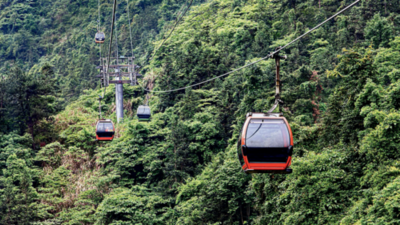- News
- City News
- shimla News
- How Shimla’s planning to rise above jams with world’s longest ropeway
Trending
How Shimla’s planning to rise above jams with world’s longest ropeway
A 40-km ropeway connecting Shimla and Parwanoo will be constructed. It will reduce travel time, boost tourism, and ease road congestion. This project aims to handle thousands of passengers daily and promises modern facilities. However, construction challenges and environmental concerns must be addressed. This futuristic initiative could serve as a model for ropeway projects in India.
The proposed project could reduce traffic on the lone highway into the state capital while making for a truly scenic ride
Those who’ve recently driven to Shimla looking to beat the heat will probably have stories about how they struggled to keep their cool as they got into the Himachal capital.
The route during holidays is often an unending crawl of bumper-to-bumper traffic, the relief of fresh winds and soothing sights near yet so far. Many would have wished they could just leap over the honking cars and land at their destination.
Those prayers are about to be answered. Literally. And in record-breaking style with a 40-km ropeway, the world’s longest.
Plan in motion
The ropeway will stretch for a little over 40km and will take Rs 5,600-crore and five years to make. Once it’s ready, it is expected to boost tourism and ease congestion on the lone highway to Shimla. It will be, by far, the longest aerial passenger transport system in India and beat its nearest existing global rival by a substantial distance.

The state govt has entrusted the project to its Ropeways and Rapid Transport System Development Corporation (RTDC).
The agency has invited proposals for the project from private players. The selected firm will have to design, finance, construct, operate and maintain the ropeway with ticket sales and lease of commercial space at stations along the route providing earnings.
Not just a flight of fancy
RTDC officials said the ropeway will provide passengers a hassle-free journey as they glide over the picturesque Himalayan landscape. It will allow them to beat the many bottlenecks and landslide-prone areas along the highway that is now frequently choked by major traffic snarls.
An estimated 22,000 vehicles operate daily on the 90-km stretch between Shimla and Parwanoo. The number rises to as much as 45,000 during weekends or in peak tourist seasons. At times, the movement of apple-laden trucks can result in travel time on the highway going up by as much as five hours.

The completion of another four-lane highway on the same route is expected to ease congestion. Though the electric ropeway will be a more eco-friendly way to travel to Shimla.
“The ropeway project will not only help alleviate traffic problems but also boost tourism in Himachal Pradesh,�?said Ajay Sharma, director, RTDC.
Multiple stops en route
The ropeway route will have 11 stops between Shimla and Parwanoo. Initial estimates say it can carry 904 passengers per hour in each direction. That translates to an annual capacity of 25 lakh.
It will feature modern cable cars equipped with either mono-cable detachable gondola (MDG) systems that can carry 8-10 passengers per car, or tri-cable 3S systems that can carry up to 25 passengers per car.
The project promises to feature state-of-the-art terminals equipped with modern passenger facilities, including waiting lounges, automated ticketing systems, and parking spaces. The e-tendering process has officially begun and work is expected to start later this year.
An aerial alternative
Amid rising urban migration, cities across the country that are struggling to expand their road networks are looking to ropeways or cable car systems as an option. In fact, in 2022, the National Highways Logistics Management Ltd, a subsidiary of National Highways Authority of India, was started to explore construction of urban ropeways in the country.
One urban ropeway project that is set to become operational is the one in Uttar Pradesh’s Varanasi. The Rs 807 crore project was started in 2022 and covers a dis tance of about 3.9 km. It’s expected to reduce travel time between Banaras Cantt railway station and Godowlia Chowk from 45 minutes to 16 minutes.
Recently, the central govt approved two ropeway projects in Uttarakhand, both of them linked to pilgrimage sites. An official release said that the 12.4km Govindghat to Hemkund Sahib ropeway will be developed at a cost of Rs 2,730 crore while the 12.9km Sonprayag to Kedarnath ropeway will cost Rs 4,081 crore.
Maharashtra is also looking to connect key locations in Mumbai and its surrounding areas via a ropeway network called the ‘Parvatmala Project�? The state govt is in the process of finalising the project details.
Points to ponder
While the Shimla ropeway project may reduce pollution in the long run, it would still need extensive environmental clearances as it passes through ecologically-sensitive zones. Just like roads, ropeway towers, too, will be at risk from landslides. Construction of the towers and installation of cables can be difficult and may delay the project.
Weather conditions in the re gion �?especially heavy snowfall and rain �?can affect the ropeway’s construction and operational efficiency. Further, unlike roads, ropeways are not an all-weather mode of transport. Factors like high wind speeds, snow and heavy rain can also create operational safety issues that may prove tricky to resolve.
But officials are hopeful that the Shimla-Parwanoo ropeway will redefine transportation in hill stattions of India. A senior official expressed hope that the project would serve as a model for other states looking to adopt modern urban mobility solutions for difficult terrain.

About the Author
Bhavika JainEnd of Article
FOLLOW US ON SOCIAL MEDIA









